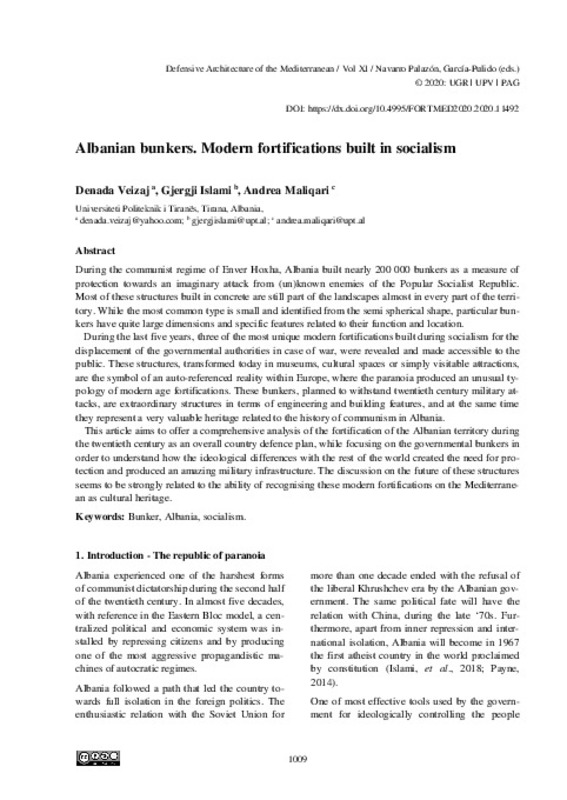JavaScript is disabled for your browser. Some features of this site may not work without it.
Buscar en RiuNet
Listar
Mi cuenta
Estadísticas
Ayuda RiuNet
Admin. UPV
Albanian bunkers. Modern fortifications built in socialism
Mostrar el registro sencillo del ítem
Ficheros en el ítem
| dc.contributor.author | Veizaj, Denada
|
es_ES |
| dc.contributor.author | Islami, Gjergji
|
es_ES |
| dc.contributor.author | Maliqari, Andrea
|
es_ES |
| dc.coverage.spatial | east=20.168331; north=41.153332; name=Albània | es_ES |
| dc.date.accessioned | 2020-06-29T07:58:54Z | |
| dc.date.available | 2020-06-29T07:58:54Z | |
| dc.date.issued | 2020-05-15 | |
| dc.identifier.isbn | 9788490488560 | |
| dc.identifier.uri | http://hdl.handle.net/10251/147116 | |
| dc.description.abstract | [EN] During the communist regime of Enver Hoxha, Albania built nearly 200 000 bunkers as a measure of protection towards an imaginary attack from (un)known enemies of the Popular Socialist Republic. Most of these structures built in concrete are still part of the landscapes almost in every part of the territory. While the most common type is small and identified from the semi spherical shape, particular bunkers have quite large dimensions and specific features related to their function and location. During the last five years, three of the most unique modern fortifications built during socialism for the displacement of the governmental authorities in case of war, were revealed and made accessible to the public. These structures, transformed today in museums, cultural spaces or simply visitable attractions, are the symbol of an auto-referenced reality within Europe, where the paranoia produced an unusual typology of modern age fortifications. These bunkers, planned to withstand twentieth century military attacks, are extraordinary structures in terms of engineering and building features, and at the same time they represent a very valuable heritage related to the history of communism in Albania. This article aims to offer a comprehensive analysis of the fortification of the Albanian territory during the twentieth century as an overall country defence plan, while focusing on the governmental bunkers in order to understand how the ideological differences with the rest of the world created the need for protection and produced an amazing military infrastructure. The discussion on the future of these structures seems to be strongly related to the ability of recognising these modern fortifications on the Mediterranean as cultural heritage. | es_ES |
| dc.language | Inglés | es_ES |
| dc.publisher | Editorial Universitat Politècnica de València | es_ES |
| dc.rights | Reconocimiento - No comercial - Sin obra derivada (by-nc-nd) | es_ES |
| dc.subject | Fortifications | es_ES |
| dc.subject | Mediterranean | es_ES |
| dc.subject | Modern age | es_ES |
| dc.subject | Built Heritage | es_ES |
| dc.subject | Bunker | es_ES |
| dc.subject | Albania | es_ES |
| dc.subject | Socialism | es_ES |
| dc.title | Albanian bunkers. Modern fortifications built in socialism | es_ES |
| dc.type | Capítulo de libro | es_ES |
| dc.type | Comunicación en congreso | es_ES |
| dc.identifier.doi | 10.4995/FORTMED2020.2020.11492 | |
| dc.rights.accessRights | Abierto | es_ES |
| dc.description.bibliographicCitation | Veizaj, D.; Islami, G.; Maliqari, A. (2020). Albanian bunkers. Modern fortifications built in socialism. Editorial Universitat Politècnica de València. 1009-1016. https://doi.org/10.4995/FORTMED2020.2020.11492 | es_ES |
| dc.description.accrualMethod | OCS | es_ES |
| dc.relation.conferencename | FORTMED2020 - Defensive Architecture of the Mediterranean | es_ES |
| dc.relation.conferencedate | Octubre 01-03,2020 | es_ES |
| dc.relation.conferenceplace | Granada, Spain | es_ES |
| dc.relation.publisherversion | http://ocs.editorial.upv.es/index.php/FORTMED/FORTMED2020/paper/view/11492 | es_ES |
| dc.description.upvformatpinicio | 1009 | es_ES |
| dc.description.upvformatpfin | 1016 | es_ES |
| dc.type.version | info:eu-repo/semantics/publishedVersion | es_ES |
| dc.relation.pasarela | OCS\11492 | es_ES |








